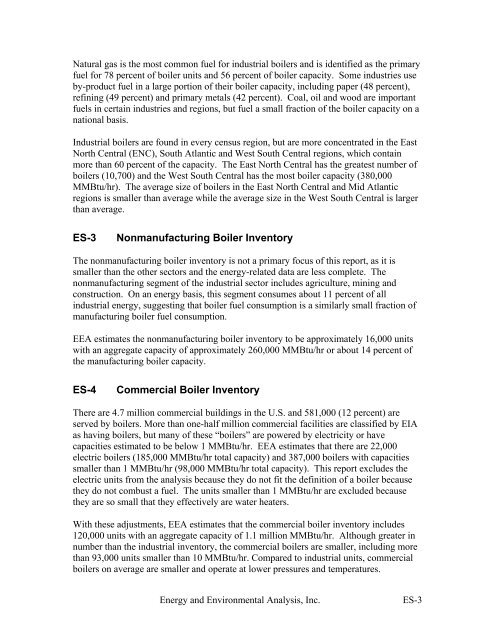Characterization of the U.S. Industrial Commercial Boiler Population
Characterization of the U.S. Industrial Commercial Boiler Population
Characterization of the U.S. Industrial Commercial Boiler Population
Create successful ePaper yourself
Turn your PDF publications into a flip-book with our unique Google optimized e-Paper software.
Natural gas is <strong>the</strong> most common fuel for industrial boilers and is identified as <strong>the</strong> primary<br />
fuel for 78 percent <strong>of</strong> boiler units and 56 percent <strong>of</strong> boiler capacity. Some industries use<br />
by-product fuel in a large portion <strong>of</strong> <strong>the</strong>ir boiler capacity, including paper (48 percent),<br />
refining (49 percent) and primary metals (42 percent). Coal, oil and wood are important<br />
fuels in certain industries and regions, but fuel a small fraction <strong>of</strong> <strong>the</strong> boiler capacity on a<br />
national basis.<br />
<strong>Industrial</strong> boilers are found in every census region, but are more concentrated in <strong>the</strong> East<br />
North Central (ENC), South Atlantic and West South Central regions, which contain<br />
more than 60 percent <strong>of</strong> <strong>the</strong> capacity. The East North Central has <strong>the</strong> greatest number <strong>of</strong><br />
boilers (10,700) and <strong>the</strong> West South Central has <strong>the</strong> most boiler capacity (380,000<br />
MMBtu/hr). The average size <strong>of</strong> boilers in <strong>the</strong> East North Central and Mid Atlantic<br />
regions is smaller than average while <strong>the</strong> average size in <strong>the</strong> West South Central is larger<br />
than average.<br />
ES-3 Nonmanufacturing <strong>Boiler</strong> Inventory<br />
The nonmanufacturing boiler inventory is not a primary focus <strong>of</strong> this report, as it is<br />
smaller than <strong>the</strong> o<strong>the</strong>r sectors and <strong>the</strong> energy-related data are less complete. The<br />
nonmanufacturing segment <strong>of</strong> <strong>the</strong> industrial sector includes agriculture, mining and<br />
construction. On an energy basis, this segment consumes about 11 percent <strong>of</strong> all<br />
industrial energy, suggesting that boiler fuel consumption is a similarly small fraction <strong>of</strong><br />
manufacturing boiler fuel consumption.<br />
EEA estimates <strong>the</strong> nonmanufacturing boiler inventory to be approximately 16,000 units<br />
with an aggregate capacity <strong>of</strong> approximately 260,000 MMBtu/hr or about 14 percent <strong>of</strong><br />
<strong>the</strong> manufacturing boiler capacity.<br />
ES-4 <strong>Commercial</strong> <strong>Boiler</strong> Inventory<br />
There are 4.7 million commercial buildings in <strong>the</strong> U.S. and 581,000 (12 percent) are<br />
served by boilers. More than one-half million commercial facilities are classified by EIA<br />
as having boilers, but many <strong>of</strong> <strong>the</strong>se “boilers” are powered by electricity or have<br />
capacities estimated to be below 1 MMBtu/hr. EEA estimates that <strong>the</strong>re are 22,000<br />
electric boilers (185,000 MMBtu/hr total capacity) and 387,000 boilers with capacities<br />
smaller than 1 MMBtu/hr (98,000 MMBtu/hr total capacity). This report excludes <strong>the</strong><br />
electric units from <strong>the</strong> analysis because <strong>the</strong>y do not fit <strong>the</strong> definition <strong>of</strong> a boiler because<br />
<strong>the</strong>y do not combust a fuel. The units smaller than 1 MMBtu/hr are excluded because<br />
<strong>the</strong>y are so small that <strong>the</strong>y effectively are water heaters.<br />
With <strong>the</strong>se adjustments, EEA estimates that <strong>the</strong> commercial boiler inventory includes<br />
120,000 units with an aggregate capacity <strong>of</strong> 1.1 million MMBtu/hr. Although greater in<br />
number than <strong>the</strong> industrial inventory, <strong>the</strong> commercial boilers are smaller, including more<br />
than 93,000 units smaller than 10 MMBtu/hr. Compared to industrial units, commercial<br />
boilers on average are smaller and operate at lower pressures and temperatures.<br />
Energy and Environmental Analysis, Inc. ES-3
















